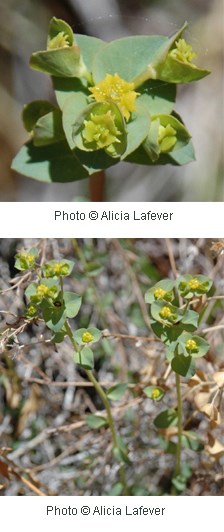
Euphorbia brachycera Family: Euphorbiaceae – Spurge Family Long-lived perennial herbs from a taproot; stems 4” to 1.5' (10 to 45 cm) tall Leaves: alternate; simple; entire; 0.28” to 1.12” (7 to 28 mm) long, 0.12” to 1” (3 to 25 mm) wide Flowers: umbel of flowers; 3 to 8 yellowish rays; cyathium 0.08” to 0.12” (2 to 3 mm) high, 0.04” to 0.08” (1 to 2 mm) wide, 4 glands; monoecious flowers borne in involucres called cyathia (involucre of fused bracts forming a cup enclosing unisexual flowers, most 5 lobed and bearing 1 to 4 glands around the margin, each gland often with a white or colored petaloid appendage); female (pistillate) flowers solitary in the center of the cyathium lacking petals and sepals; ovary 3-loculed; 3 styles; male (staminate) flowers without petals or sepals, grouped in 5 clusters Pollinators: other Euphorbia species are pollinated by insects Fruits: capsule Blooms in Arches National Park: April, May, June Habitat in Arches National Park: hanging garden, desert shrub and pinyon-juniper communities Location seen: outside Arches National Park near Corona Arch Other: The genus name, “Euphorbia” is in honor of Euphorbus the Greek physician of Juba II, King of Mauretania. The word Euphorbus derives from “eu” which means "good" and “phorbe” which means "pasture or fodder," thus giving “euphorbos” the meaning "well fed". The species name, “brachycera” means “short-horned”. The sap contains a latex. The poinsettia is Euphorbia pulcherrima. |
Last updated: April 29, 2025
